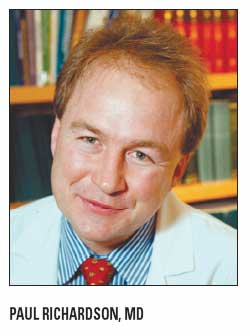Bortezomib combination offers favorable response rate in relapsed multiple myeloma
SAN FRANCISCO-A regimen of perifosine, bortezomib (Velcade), and dexamethasone provides favorable outcomes with manageable toxicities, even in heavily pretreated multiple myeloma patients, according to data presented at ASH 2008.
SAN FRANCISCO-A regimen of perifosine, bortezomib (Velcade), and dexamethasone provides favorable outcomes with manageable toxicities, even in heavily pretreated multiple myeloma patients, according to data presented at ASH 2008.

“We were encouraged by the relatively high response rate of 21%, given the heavily pretreated characteristics of our patient population,” said Paul Richardson, MD, of the Dana-Farber Cancer Institute in Boston.
In phase I/II trials, the optimal dose was determined to be 50 mg of perifosine daily and 1.3 mg/m2 of bortezomib on days 1, 4, 8, and 11 of a 21-day cycle. A phase I trial had shown signifi cant GI toxicity at higher doses of perifosine over time, Dr. Richardson said. Dexamethasone at a dose of 20 mg, given on the day of and aft er each bortezomib dose, was available for patients with progressive disease (abstract 870).
Patients in the trial had a median number of five prior therapies and all were relapsed or refractory to bortezomib. Almost one-third had received a stem cell transplant. Patients had advanced disease, with 67% classified as Durie-Salomon stage III at diagnosis.
Seventy-two patients were available for evaluation. In these patients, the overall response rate (for treatment with perifosine, bortezomib, and dexamethasone) was 38%. When best response was assessed, 4% of patients achieved a complete response and 17% a partial response.
The median time to response was rapid (about five cycles). When the investigators analyzed the responses of bortezomibrefractory patients, they also found a favorable response rate of 31% when dexamethasone was added to the combination regimen. The median time to progression was 6.3 months; in those who responded, it was 8.8 months.
Significant toxicities occurred, but most were controllable with dose reduction and supportive care, Dr. Richardson said. Although there was a significant amount of GI toxicity, including diarrhea, a reduction of perifosine dose rendered such symptoms manageable. Sixteen percent of patients showed symptomatic peripheral neuropathy, but only one patient had grade 3 neuropathy, and there were no instances of grade 4 neuropathy. Thirteen percent of patients also exhibited hypoglycemia. Most important, however, there were no treatment- related mortalities.
“This triplet of agents is active and generally well tolerated in a heavily pretreated population,” Dr. Richardson said.
A phase III trial is planned that will examine the efficacy and tolerability of a regimen of perifosine, bortezomib, and dexamethasone against bortezomib, dexamethasone, and placebo, he added.